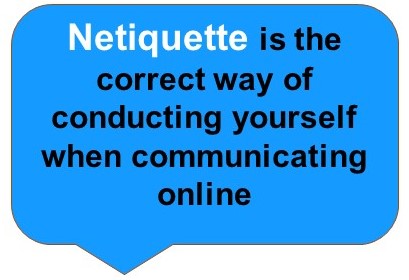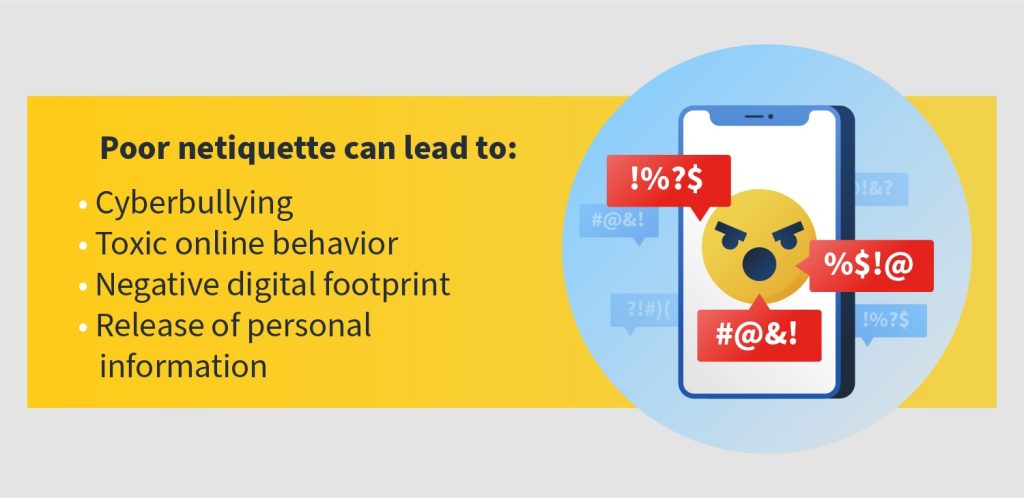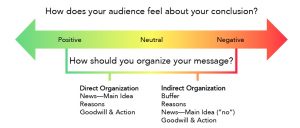7.2 Message Structure
Good customer service, employee relations, and relationship building are essential in sustaining any business. The way you represent yourself in writing carries significant weight. As such, how you communicate will have everything to do with whether or not you achieve your goal. Whether you are communicating good news or trying to persuade someone to agree with your ideas, making strategic decisions about key information placement in your document will make your task a lot easier. Given that most messages are now transmitted in an electronic form, it is also important to consider the digital context within which your messages are sent and received. This chapter will guide you in making good decisions when composing your business messages. First, we will discuss netiquette.
Netiquette

Text messaging, emailing, and posting on social media in a professional context requires that you be familiar with “netiquette,” or proper etiquette for using the internet. We have all heard the news stories about people who have been fired and companies that have been boycotted for making offensive or inappropriate social media posts. People have even gone to prison for illegal use of private messaging. The digital world may seem like a free-for-all, “wild wild west” with no clear rules or regulations; however, this is clearly a dangerous perspective for a professional to take, as the consequences for breaking tacit rules, expectations, and guidelines for professional communications can be very costly.
Writing in an online environment requires tact, skill, and an awareness that what you write may be there for a very long time and maybe seen by people you never considered as your intended audience. From text messages to memos to letters, from business proposals to press releases, your written business communication represents you and your company: Your goal is to make your messages clear, concise, constructive, and professional.
We create personal pages, post messages, and interact via online technologies as a normal part of our careers, but how we conduct ourselves can leave a lasting image, literally. The photograph you posted on your Instagram page or Twitter feed may have been seen by your potential employer, or that insensitive remark in a Facebook post may come back to haunt you later.
Following several guidelines for online postings, as detailed below, can help you avoid embarrassment later:
- Know your context
- Carefully analyze the communication situation: audience, purpose, and environment.
- Adapt the language and tone of the message accordingly.
- Avoid assumptions about your readers; remember that culture influences communication style and practices.
- Familiarize yourself with the Acceptable Use of IT Resources policy at your organization.
- Remember the human aspect
- Introduce yourself.
- Remember there is a person behind the words; ask for clarification before making a judgment.
- Check your tone before you publish; avoid jokes, sarcasm, and irony as these can often be misinterpreted and get “lost in translation” in the online environment.
- Respond to people using their names.
- Remember that culture, age, and gender can play a part in how people communicate.
- Remain authentic and expect the same of others.
- Remember that people may not reply immediately. People participate in different ways, some just by reading the communication rather than jumping into it.
-
Recognize that text is permanent
-
Be judicious and diplomatic; what you say online may be difficult or even impossible to retract later.
-
Think in terms of how you are representing your organization.
-
Agree on ground rules for text communication (formal or informal; seek clarification whenever needed) if you are working collaboratively.
-
- Avoid flaming: Research before you react
- Accept and forgive mistakes.
- Consider your responsibility to the group and to the working environment.
- Seek clarification before reacting; what you heard is not always what was said.
- Ask your supervisor for guidance.*
- Respect privacy and original ideas
- Quote the original author if you are responding with a specific point made by someone else.
- Ask the author of an email for permission before forwarding the communication or otherwise using their message content.
- Familiarize yourself with the Copyright and Privacy policies at your organization.
* Sometimes, online behavior can appear so disrespectful and even hostile that it requires attention and follow-up. In this case, let your supervisor know right away so that the right resources can be called upon to help.

For further information on netiquette, check out the following links:
- Business Insider: Email etiquette rules every professional needs to know
- LinkedIn: Email Etiquette
Knowledge Check
Message Structure
Messages in business are organized specifically to address not only the content and context, but also your purpose and especially the needs of the audience. Routine messages may make requests, inform, give direction, deliver unpleasant news, confirm agreements or arrangements, transmit documents or invitations. You would organize the message according to how the audience is likely to receive your message: placing the key idea at the beginning when the message is positive or neutral or placing the message near the close when the message is persuasive or negative. The tone of the content is very much affected by how you structure the message, so making wise decisions based on careful audience and content analyses will result in a successful document. For example, you would not place a refusal statement in the very opening of a letter because that would be too brusque; rather, you would create a buffer and place the negative news after the explanation. Completing a thorough audience and context analysis in your pre-writing phase will make the task of composing your message with the audience front-of-mind.
Messages in business can be broadly categorized as being positive, neutral, persuasive, or negative.
Positive messages: Positive messages serve to transmit good news or establish good will.
Neutral messages: Neutral messages are highly routine and do not contain emotionally-charged information. These messages usually simply convey information or make routine requests.
Persuasive messages: Persuasive messages have as their purpose the influence of opinion or behavior. As such, these messages must be skillfully composed with well-considered reasoning.
Negative messages: Negative messages, also known as bad news messages, contain information that the reader typically will not welcome or will resist.
These will each be discussed in the following chapters.
How you will structure the message will depend on the type of message you must create. Here is a brief overview of the basic strategies for organizing of business messages.
Knowledge Check
Key Strategies in Structuring Messages
Strategy 1: Four-Part Structure
Effective business messages consist of a basic four-part structural convention. This structure creates a formalized and recognized predictability in the communication such that the audience knows what type of information is to appear in any specific part of a message. It ensures that messages can be quickly read and contributes to their clarity, conciseness, and coherence. Below is the basic four-part structure:
Opening: In correspondence, the opening usually consists of a single brief paragraph which introduces the subject and states the main purpose or message.
Background: The background explains the context or situation that led to the message. When the message is very brief, the background may be incorporated into the opening paragraph.
Details: The details consist of the explanation and facts that will enable the reader to understand the situation and take appropriate action if necessary.
Close: The close is where you would (re)state your requested action and/or end with good will.
Strategy 2: Direct and Indirect Organization
We typically recognize the placement of the main idea within the context of a larger organizational strategy known as the direct and indirect methods. You decide to use one or the other based on the communication situation and how the audience is most likely to respond to your message. If your audience is likely to respond in a positive or neutral manner, you would use the direct method. If your audience is likely to respond in a negative manner or if they need persuasion, you would use the indirect method (see Figure 7.2.1 for an overview of the spectrum).

Figure 7.2.1 Direct and indirect organization (Kendall, n.d.).
The following video, Direct and Indirect Approaches (2019) provides clarification on when to use each approach through a practical application of the strategy.
Strategy 3: Key Idea Placement
An important element in any message is the key idea or main message. The key idea is usually contained in a single sentence and announces to the reader your purpose for communicating. The key idea can appear in the opening paragraph or it can be placed closer to the close depending on how you expect the reader to receive your message. Examples of key ideas are as follows:
Please find enclosed our report entitled “Internal Inconsistencies in Workflow Management,” which you requested at our January 31 meeting.
You are requested to send us your updated résumés by Friday, February 11, so we may include them with the Grenville location proposal.
Following Ontario Public Health recommendations, please wear your mask at all times when in the workplace.
Generally speaking, for positive or neutral messages, the key idea will appear in the opening; for negative or persuasive messages, the key idea will be placed near or at the close. Where you place the key idea will depend on a number of factors. Here you may realize the importance of completing a good audience and context analysis, so you can adapt your message skilfully. Here in Table 7.2.1 is a quick overview of some considerations to keep in mind:
Table 7.2.1 Key Idea Placement
| Consideration | Key Idea Placement |
| When the message is positive or neutral | Place the key idea in the opening paragraph |
| When writing to inform or give direction | Place the key idea in the opening paragraph |
| When the reader is receptive to your message | Place the key idea in the opening paragraph |
| When the message is negative and the reader is likely to be displeased | Place the key idea near or at the close following a buffer and explanation |
| When the reader is resistant | Place the key idea near or in the close |
| When creating a persuasive request or sales message | Place the key idea near or in the close |
| When refusing a request | Place the key idea near or in the close |
The following chapters will illustrate the placement of key ideas and the use of the direct and indirect methods in the context of sample messages serving various purposes.
Knowledge Check
References
Huong, D. (2019). Direct and indirect approach [Video}. Youtube. https://www.youtube.com/watch?v=L-uB33AfqMo&t=1s
Kendall, S. (n.d.). Planning business messages. Business communication skills for managers. Lumen Learning. https://courses.lumenlearning.com/wm-businesscommunicationmgrs/chapter/planning-business-messages/

